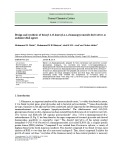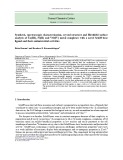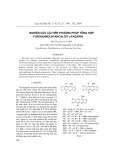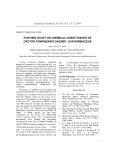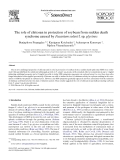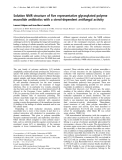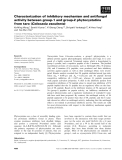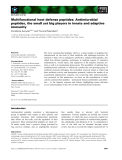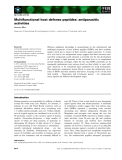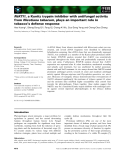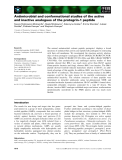
Anti-fungal activity
-
These results revealed strain-dependent antifungal activity. Our study indicates that the use of these lactic acid bacteria can be applied as a biocontrol of fungal growth and mycotoxins production.
 6p
6p  mudbound
mudbound
 10-12-2021
10-12-2021
 6
6
 1
1
 Download
Download
-
Green synthesis method is being increasingly used in the development of safe, stable, and eco-friendly nanostructures with biological resources. In this study, extracellular and intracellular synthesis of gold nanoparticles (AuNPs) was carried out using green algae Chlorella sorokiniana Shihira & R.W. Fresh algae were isolated and identified from Musaözü Pond located in the province of Eskişehir and then extraction process were performed.
 18p
18p  thiencuuchu
thiencuuchu
 27-11-2021
27-11-2021
 11
11
 3
3
 Download
Download
-
The structure activity relationship (SAR) study revealed that incorporation of 4-O-lauroyl group in rhamnopyranoside frame work along with 2,3-di-O-acyl group increased the antifungal potentiality of the rhamnopyranosides.
 10p
10p  tocectocec
tocectocec
 25-05-2020
25-05-2020
 8
8
 1
1
 Download
Download
-
A new series of transition metal complexes of Co(III), Ni(II) and VO(IV) was synthesized with the bidentate Schiff base ligand (HL) derived from the condensation of 2-amino-3-benzyloxypyridine and 5-bromo salicylaldehyde.
 14p
14p  tocectocec
tocectocec
 25-05-2020
25-05-2020
 23
23
 2
2
 Download
Download
-
The objective of the present investigation was to isolate and identify the antimicrobial activity showing actinomycetes associated with sponges. Sponges such as Acanthella klethra, Theonella cylendrica, Helicona sp., Auletta sp., and Callyspongia sp. were collected at Sangumal, in Rameswaram island, Ramanathapuram District, Tamil Nadu, India. Isolates of 22 actinomycetes were isolated from sponges. Isolates No. 16 showed high antibacterial and antifungal activity and the isolate was identified as Streptomyces sp.
 8p
8p  cothumenhmong5
cothumenhmong5
 17-05-2020
17-05-2020
 13
13
 1
1
 Download
Download
-
Recently, some of the furoquinoline alkaloids were found to have an interesting biological activity, for example, anti-cancer, antiplatelet aggregation and antifungal activities. The interesting biological activity made these compounds 1-13 attractive targets in organic chemistry. A novel generally applicable synthesis of furoquinolines is described. The condensation of 2- methoxy aniline and malonic acid in the presence of POCl3 gave 2,4-dichloro-8- methoxyquinoline. Then, treatment of this compound with sodium methoxide in methanol under reflux afforded 4,8-dimethoxyquinoline.
 5p
5p  uocvong04
uocvong04
 24-09-2015
24-09-2015
 68
68
 5
5
 Download
Download
-
The lupane triterpenoid lupeol is found in a variety of plants. Its biological activities have attracted a great deal of interests. A number of studies on the antiinflammatory, antimycobacterial, antimalarial and anticancer activities of this compound and its derivatives have been reported. Based on our knowledge, there have not been any reports on the antimicrobial activity of lupeol and its derivatives.
 5p
5p  uocvong04
uocvong04
 24-09-2015
24-09-2015
 64
64
 3
3
 Download
Download
-
Croton tonkinensis Gagnep., commonly named in Vietnamese as "Kho sam Bac Bo", is a tropical shrub native to the Northern Vietnam. Its dried leaves (Folium Tonkinensis) have been used in Vietnamese traditional medicine to treat boils, abscesses, impetigo, abdominal pain, dyspepsia, dysentery, gastric and duodenal ulcers [1, 2]. The plant is of our interest since its varied biological activities demonstrated in our various in vitro bioassays including anti-inflammatory, anticancer, antiplasmodial, antibacterial and antifungal.
 2p
2p  uocvong04
uocvong04
 24-09-2015
24-09-2015
 56
56
 3
3
 Download
Download
-
The role of chitosan in protection of soybean from sudden death syndrome caused by Fusarium solani f. sp. glycines has many contents: introduction, methods, fungal culture and growth, evaluation of the role of chitosan in protection of soybean from SDS development, chitinase activity assay in soybean leaves, statistical analysis, eVects of chitosan as a natural antifungal agenton inhibition of the radial and submerged growth ofF. solani f. sp. glycines,...
 6p
6p  cscpubka
cscpubka
 05-05-2014
05-05-2014
 88
88
 2
2
 Download
Download
-
Glycosylatedpolyenemacrolide antibiotics, as nystatins and amphotericins, are amphiphilic structures known to exert antifungal activity by disrupting the fungal cell membrane, leading to leakage of cellular materials, and cell death. This membrane disruption is strongly influenced by the presence and the exact nature of the membrane sterols.
 9p
9p  research12
research12
 23-04-2013
23-04-2013
 39
39
 2
2
 Download
Download
-
Tarocystatin from Colocasia esculenta, a group-2 phytocystatin, is a defense protein against phytopathogenic nematodes and fungi. It is com-posed of a highly conserved N-terminal region, which is homological to group-1 cystatin, and a repetitive peptide at the C-terminus.
 10p
10p  vinaphone15
vinaphone15
 28-02-2013
28-02-2013
 40
40
 2
2
 Download
Download
-
The term ‘antimicrobial peptides’ refers to a large number of peptides first characterized on the basis of their antibiotic and antifungal activities. In addition to their role as endogenous antibiotics, antimicrobial peptides, also called host defense peptides, participate in multiple aspects of immunity (inflammation, wound repair, and regulation of the adaptive immune sys-tem) as well as in maintaining homeostasis.
 12p
12p  viettel02
viettel02
 20-02-2013
20-02-2013
 45
45
 3
3
 Download
Download
-
Whereas significant knowledge is accumulating on the antibacterial and antifungal properties of host defense peptides (HDPs) and their synthetic mimics, much less is known of their activities against parasites. A variety ofin vitro andin vivo antiparasitic assays suggest that these notorious anti-microbial compounds could represent a powerful tool for the development of novel drugs to fight parasites in the vertebrate host or to complement current therapeutic strategies
 9p
9p  viettel02
viettel02
 20-02-2013
20-02-2013
 40
40
 3
3
 Download
Download
-
A cDNA library from tobacco inoculated withRhizoctonia solaniwas con-structed, and several cDNA fragments were identified by differential hybridization screening. One cDNA clone that was dramatically repressed, NtKTI1, was confirmed as a member of the Kunitz plant proteinase inhibi-tor family. RT-PCR analysis revealed that NtKTI1was constitutively expressed throughout the whole plant and preferentially expressed in the roots and stems.
 13p
13p  viettel02
viettel02
 19-02-2013
19-02-2013
 34
34
 4
4
 Download
Download
-
The natural antimicrobial cationic peptide protegrin-1 displays a broad spectrum of antimicrobial activity and rapidly kills pathogens by interacting with their cell membrane. We investigated the structure–activity relation-ships of three protegrin-1 analogues: IB-367 (RGGLCYCRGRFCVCVGR-NH2), BM-1 (RGLCYCRGRFCVCVG-NH2) and BM-2 (RGLCYRPRFV CVG-NH2). Our antimicrobial and antifungal activity studies of these peptides showed that BM-1 was much more active than IB-367 against Gram-positive bacteria and fungi, whereas BM-2 was inactive. ...
 13p
13p  mobifone23
mobifone23
 18-01-2013
18-01-2013
 54
54
 4
4
 Download
Download
CHỦ ĐỀ BẠN MUỐN TÌM










